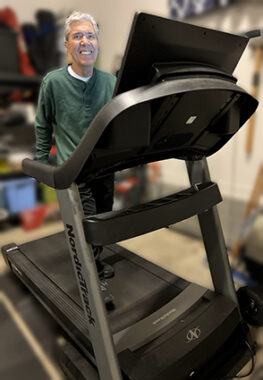13 essential ways I stay healthy with Fabry disease
Improving my well-being enables me to live a better and longer life

This week, I turned 69 years old. As a man with classic Fabry disease, I consider this achievement both significant and unexpected. I’m still getting used to the idea that living this long is possible for people like me, after believing that it wasn’t for most of my adult life. Medical literature indicates a shorter life span for Fabry patients, and five of my family members died between the ages of 37 and 51 from complications related to the disease.
My birthday, Nov. 20, also marked 21 years that I’ve received intravenous enzyme replacement therapy (ERT), one of the approved treatments for Fabry. For many years, I received ERT every two weeks. Now, I get an infusion every 10 to 11 days, in hopes of preventing my chronic kidney disease from advancing to stage 4. I’m thankful to no longer have heart disease since my heart transplant three years ago.
Receiving ERT feels like a full-time job. I drive to Duke University Medical Center every 10 or 11 days to sit in a chair with an IV catheter stuck in my arm for about three hours. With driving to and from the clinic, spending many hours in the chair, and receiving about a thousand IV sticks, it’s a significant burden on my life. But while it’s highly inconvenient, it’s not intolerable. I’m grateful for the therapy!
The primary upside is that ERT has slowed the progression of my disease, allowing me to live longer. As a bonus, I can get a lot of computer work done during my time in the chair.
Until I became a senior citizen, a term I’m still not comfortable saying out loud, I didn’t think aging required effort. Aging just happens. But with a goal of living another 10 years or so, I realize physical and mental effort will be required to reach my goal. I now read a lot about how to stay healthy, especially as we age.
Taking steps to improve my well-being
I discovered a resource from the American Heart Association called Life’s Essential 8, which details ways we can improve and maintain cardiovascular health to help us enjoy a longer, healthier life. Its purpose aligns perfectly with a motto of the National Fabry Disease Foundation (NFDF): “Fighting Fabry Disease … Living Better Longer.” As NFDF president, I’m happy to provide a real-life example of our motto.
Life’s Essential 8 outlines eight steps people can take to live a healthier lifestyle:
- Eat better
- Be more active
- Quit tobacco
- Get healthy sleep
- Manage weight
- Control cholesterol
- Manage blood sugar
- Manage blood pressure.
These eight steps are important for everyone, but especially for people with Fabry disease, who are at a greater risk for heart disease, kidney disease, lung disease, and stroke. In addition to minimizing these life-threatening risks, these practices can ease disease manifestations that hurt our quality of life.
For me, the following steps also have been critical to my overall health and well-being:
- Take a Fabry-specific treatment
- Adhere to the schedule of tests recommended for people for Fabry, such as periodic cardiac and cranial MRIs
- Stay well hydrated
- Manage albuminuria (elevated albumin in the urine) and proteinuria (elevated protein in the urine) — both of which may indicate kidney issues — with an adjunct therapy, in addition to my Fabry-specific treatment
- Manage lower leg edema, a common issue in Fabry, by wearing compression socks.

Jerry on the treadmill. (Courtesy of Jerry Walter)
The heart association’s recommendations, along with my personal steps, make up my “Life’s Essential 13” — the ways I stay as healthy as possible with Fabry disease. I’m fortunate to score well when evaluating my adherence to these 13 steps.
Some of my success is just me being fortunate, while other elements require effort. For example, getting enough quality exercise and consistently eating healthily can be difficult to accomplish with my busy work schedule. Many people without Fabry disease probably face the same issues, but a chronic illness can add a layer of complexity.
My physical therapy exercise routine helps me manage chronic lower back pain and chronic burning in my quadriceps. It also counteracts some of the damage caused by sitting at my desk too much. Brisk walking outside or on a treadmill in my garage is critical to maintaining my mental and physical health.
I hope sharing my essential steps helps others to develop their own and to live better and longer lives. With the current Fabry treatments and the prospect of new, improved therapies, living to my age should no longer be an anomaly for those with classic Fabry.
Note: Fabry Disease News is strictly a news and information website about the disease. It does not provide medical advice, diagnosis, or treatment. This content is not intended to be a substitute for professional medical advice, diagnosis, or treatment. Always seek the advice of your physician or other qualified health provider with any questions you may have regarding a medical condition. Never disregard professional medical advice or delay in seeking it because of something you have read on this website. The opinions expressed in this column are not those of Fabry Disease News or its parent company, Bionews, and are intended to spark discussion about issues pertaining to Fabry disease.








Comments
Diane Rothman
useful and well written article. Discouraging news about the trials, great information about what to do to live better longer!
Jerry Walter
Thank you, Diane!
Eric
Hi Jerry,
Wonderful tips you are sharing with the Fabry Community! Might I add a few suggestions as well?
-Practice daily gratitude (keep a daily gratitude journal if possible, share with loved ones if applicable)
-Have your eyes examined once a year. I take prednisone and my opthamologist monitors a cataract I have.
-Communicate thoroughly and effectively with your ERT Care Team. Effective communication is essential for
maximum enzyme therapy care.
Thank you for your efforts Jerry!
Eric Price
Huntersville, NC
Jerry Walter
Thank you, Eric, for your useful suggestions.